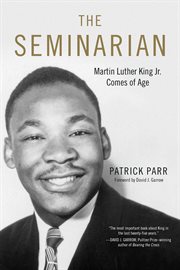Review by Booklist Review
Parr accounts more fully for Martin Luther King Jr.'s seminary education than has any complete biography of the civil rights icon. This is worth doing because King's three years at Crozer Theological Seminary, in Chester, Pennsylvania, are the period in which the smart, capable youngster became the charismatic, mission-driven man. Charting King's progress through each year's three terms and the punctuating summers spent assisting his famous-preacher father, Parr brings to life every professor, fellow student, and mentor who influenced King, usually becoming lifelong friends as they did. King's progress was steeply upward in his course work and social context, and he graduated as president as well as being at the top of the class of 1951. He had learned theology, of course, but also about black-white relations in the North, partly through considering marriage to white Betty Moitz. A journalist rather than an academic, Parr writes appreciatively and even informally about his subject and drops a few gossipy tidbits, including King's habitual plagiarism in his school papers and why his professors seldom noticed it.--Olson, Ray Copyright 2018 Booklist
From Booklist, Copyright (c) American Library Association. Used with permission.
Review by Publisher's Weekly Review
Historian Parr's debut work of nonfiction is a true life bildungsroman, in which the protagonist, a young man by the name of Martin Luther King Jr., grows up to be a world famous theologian and preacher. The book looks specifically at a formative yet largely overlooked period in King's life, beginning in 1948, when the then 19-year-old left his home in Atlanta, Ga., and headed north to attend divinity school at the Crozer Theological Seminary in Chester, Pa. Parr provides an in-depth account of the curriculum, which included introductory courses on the history and literature of the New Testament, practical and technical courses such as one on how to conduct a sermon over the radio, and more radical courses like Christianity and Study, in which King studied Walter Rauschenbusch's social gospel, which he often echoed later in his career when preaching to white audiences. Parr enriches the discussion of King's formal studies with insights into King's relationships with professors and fellow seminarians, and even discusses King's shortcomings as a student (Parr notes, for example, that King's poor grasp of citation rules would not fly today). Often overlooked or relegated to mere footnotes in previous biographies, Parr highlights this short, influential period in King's life, fleshing out the details of courses, teachers, mentors, pals, and dates, and presenting a fresh portrait of King, the "rookie preacher." Photos. (Apr.) © Copyright PWxyz, LLC. All rights reserved.
(c) Copyright PWxyz, LLC. All rights reserved
Review by Kirkus Book Review
The experiences of and changes in Martin Luther King Jr. during his three years (1948-1951) at Crozer Theological Seminary in Chester, Pennsylvania.Parr, a historian who has written about King in Seattle Magazine and elsewhere, debuts with a work that focuses sharply on a somewhat neglected period of the Nobel laureate's life (1929-1968), the period when he left homeand paternal expectationsin Atlanta, traveled north, and began discovering who he was and what he must do. The text, sturdily chronological, features some key biographical details: for each term, we see the class schedule of King (whom the author refers to as "ML" throughoutas did King's intimates); the course descriptions from the Crozer catalog; and detailed information about his professors and classmates. Quoting occasionally from the papers King wrote at Crozer, the author is fearless about recording and commenting on King's patent plagiarism; he was fond of writing extensive passages, sometimes almost verbatim from his sources, and neglecting quotation marks or any form of citation. Although Parr doesn't excuse King's academic deceit, he does note that King's professors never did anything about it. The author also explores King's personal life during these years: his friends, his leisure activities (including pool and basketballgood at the former, not the latter), and his love life, including a rather extensive relationship with the white daughter of Crozer's cook, a relationship that worried friends and others. The late 1940s and early 1950s, even in the North, were not especially tolerant of interracial dating. Parr concludes with King's admission to the doctorate program at Boston University and finishes with some updates on key characters and on Crozer itself, now merged elsewhere, its campus closed.A cleareyed and honest account of some transformative experiences in the life of the gifted young man who would become a cultural icon. Copyright Kirkus Reviews, used with permission.
Copyright (c) Kirkus Reviews, used with permission.

